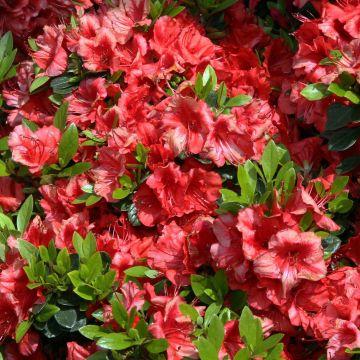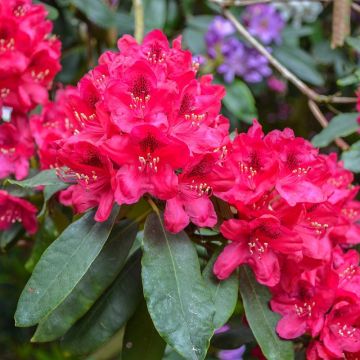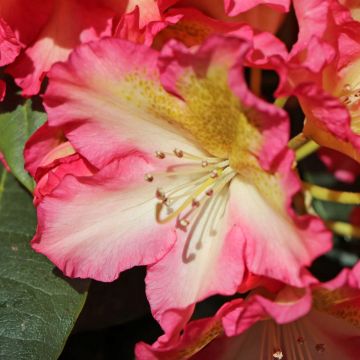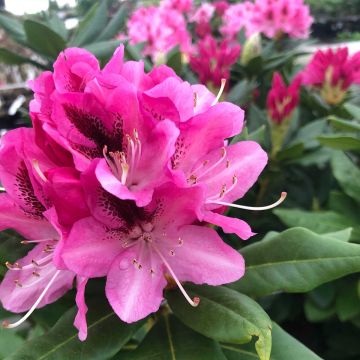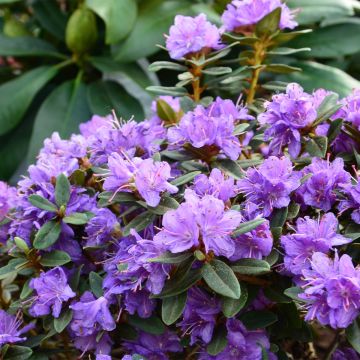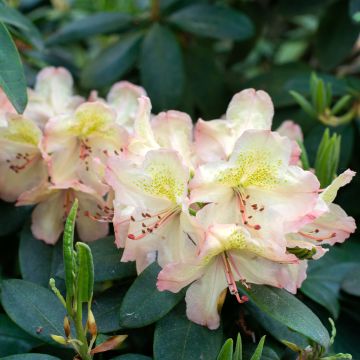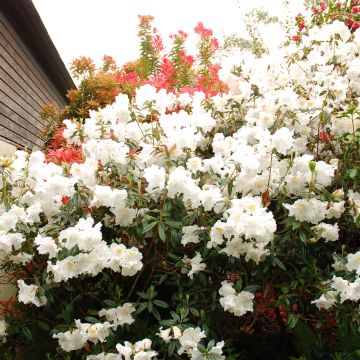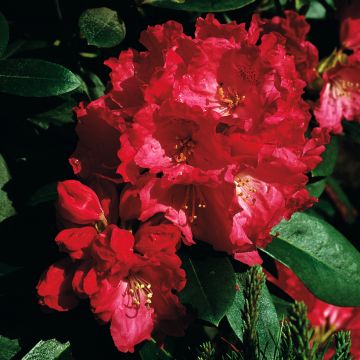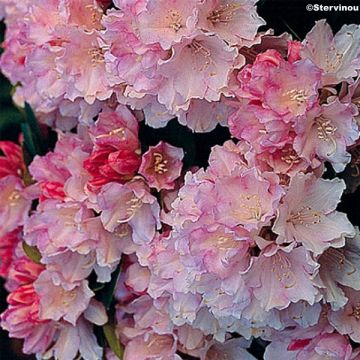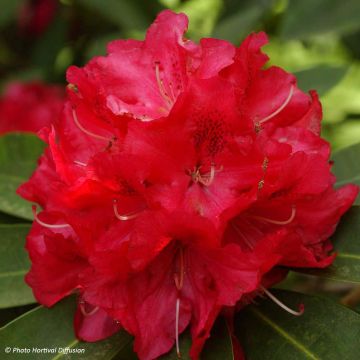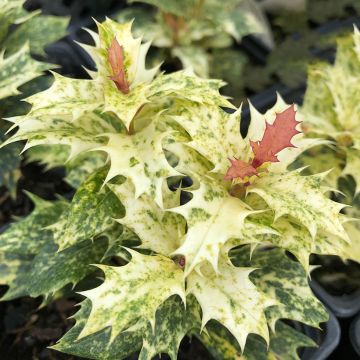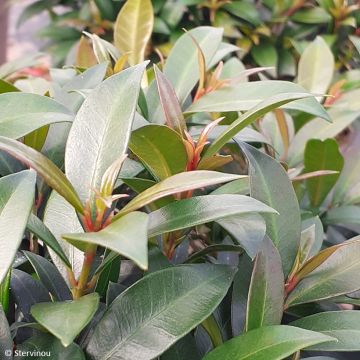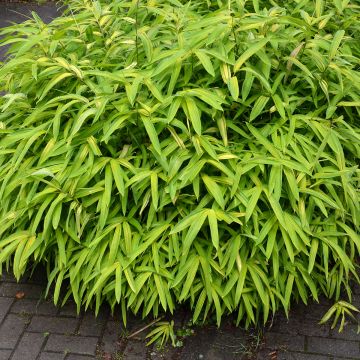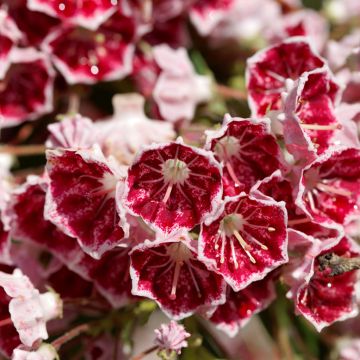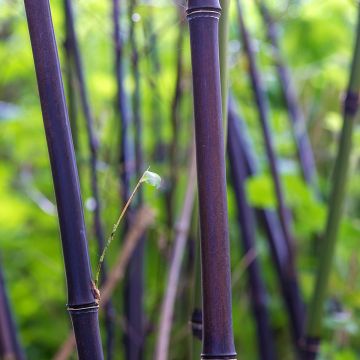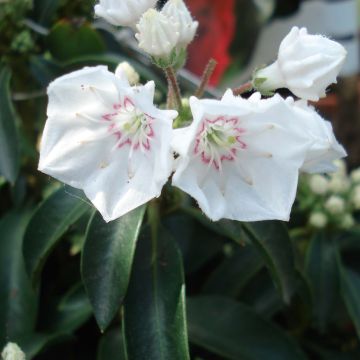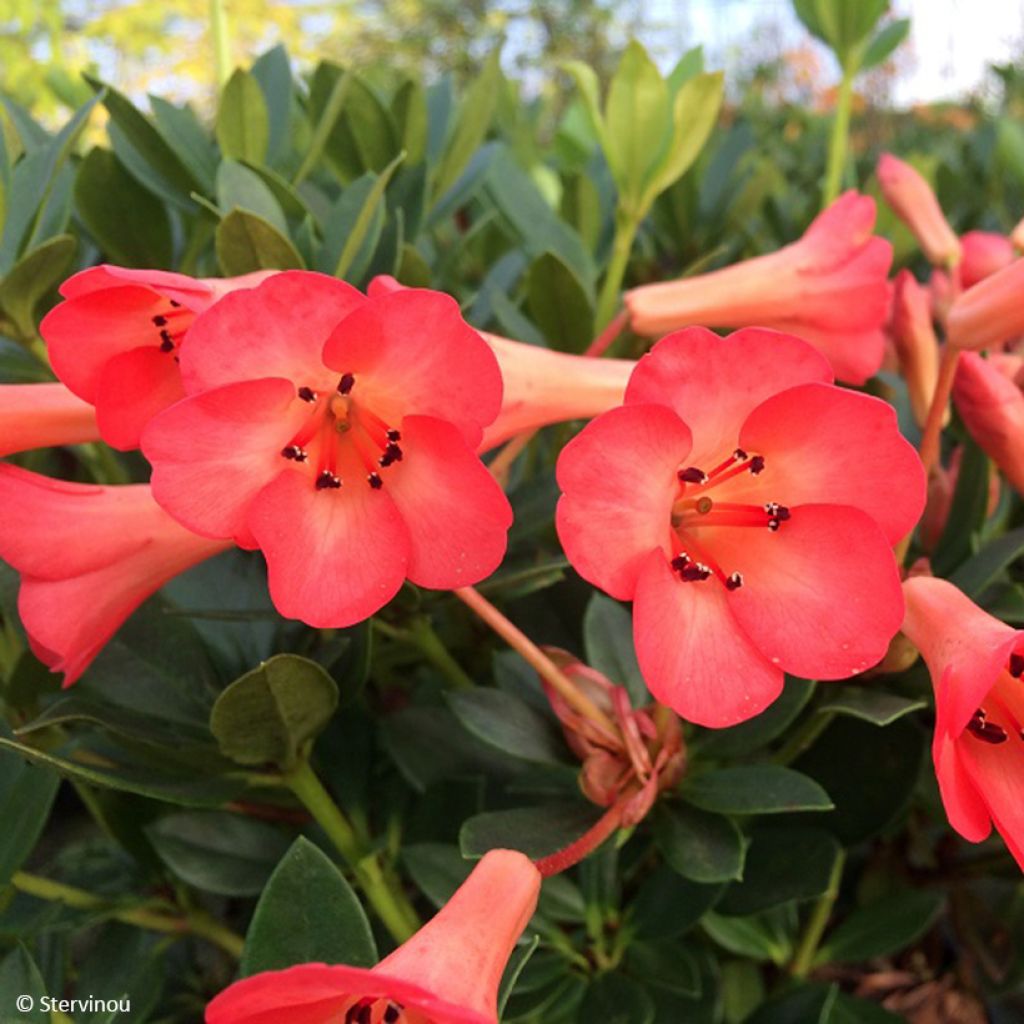

Rhododendron vireya Saxon blush - Tropical Rhododendron
Rhododendron vireya Saxon blush - Tropical Rhododendron
Rhododendron Saxon blush
Tropical Rhododendron
This item cannot be shipped to the selected country
Delivery charge from €5.90
More information
Schedule delivery date,
and select date in basket
This plant carries a 24 months recovery warranty
More information
We guarantee the quality of our plants for a full growing cycle, and will replace at our expense any plant that fails to recover under normal climatic and planting conditions.
From €5.90 for pickup delivery and €6.90 for home delivery
Express home delivery from €8.90.
Does this plant fit my garden?
Set up your Plantfit profile →
Description
Rhododendron 'Saxon Blush' is a superb variety of tropical origin with a particularly compact habit. This almost dwarf shrub has dense, evergreen foliage that is dark green and ornamental all year round. It blooms repeatedly over a very long period in autumn and winter and sometimes even blooms again in summer. It is adorned with a multitude of small, salmon-pink trumpet-shaped flowers, with an undeniable romantic charm. It is not very hardy so should be grown in a pot to be overwintered indoors and protected from frost.
Rhododendrons belong to the Ericaceae family, which includes about a hundred genera, such as the classic Arbutus or Heather, and also includes some lesser-known beauties, such as Oxydendron arboreum, or Tree Andromeda. With 850 species, the Rhododendron genus includes both shrubs and trees that can reach a height of 15m. This diversity justifies a fairly detailed botanical classification, with subgenera, sections, and subsections. In addition to the hardy Rhododendrons in our gardens (which also include Azaleas, a purely horticultural term), the Vireya section includes no less than 300 tropical species. Growing in a geographical area ranging from Malaysia to the Philippines, and from Indonesia to Papua New Guinea, these plants are often epiphytic (growing on trees, like many tropical orchids) and tend to bloom almost all year round.
'Saxon Blush' is a variety from this section, semi-epiphytic and can be grown in the ground. It is the result of Oswald Blumhardt's selection work in New Zealand, who obtained it by crossing the 'Hot Tropic' variety, a red and yellow bicoloured hybrid, with Rhododendron saxifragoides. This latter species is very unique, as it is terrestrial and not epiphytic, developing a long taproot capable of infiltrating the crevices of the rocks on which it grows. Forming a 15cm tall ground cover, with very small leaves (3.5 x 0.7cm), and topped with small red flowers, 3.5cm in diameter, borne on long pedicels (up to 9cm). Endemic to New Guinea (in the southern hemisphere), this alpine plant grows at high altitudes (from 3200 to 4000m) and blooms between August and December.
With such heritage, it is not surprising that 'Saxon Blush' stands out from other Vireya. It forms a more compact shrub, not exceeding 40 to 50cm in height and width, after a rather slow growth. Its habit is fairly regular, giving a well-balanced sphere of beautiful stature. The glossy dark green foliage consists of small elliptical leaves about 3-4cm long, very close to each other due to particularly short internodes. It forms a very dense and truly aesthetic cushion of vegetation, whose dark green colour enhances the light-coloured flowering. This flowering occurs repeatedly during autumn and winter, and sometimes even in summer, providing an extremely attractive flowering pot for a good part of the year. The flowers, in clusters of 5 to 8 units, have a trumpet shape, with the tubular base formed by the fused petals on the pedicel side, a morphological characteristic of Ericaceae (known as gamopetalous flowers). The corolla then opens up to rounded petals, in a beautiful salmon-pink colour, slightly darker along the petal edges and lighter in the throat and on the outer surface. A cluster of stamens with dark red anthers emerges from the heart of the flower, creating a nice contrast. The numerous flowers, longer than the leaves, are perfectly in harmony with the dark green of the foliage.
Rhododendron vireya are tropical plants and although 'Saxon Blush' can tolerate light frosts, it is best to avoid this stress by growing it in a pot and bringing it indoors to a bright, frost-free room in winter. This will also ensure that it has an acidic, moisture-retentive and well-draining substrate to meet its needs. In the summer, place the pot in the light shade of taller plants to protect it from harsh sunlight while benefiting from some humidity (due to the transpiration of other plants). You can create an exotic setting by accompanying it with conservatory plants, such as Kumquat 'Fukushu', which will reward you with its fragrant summer flowering and small oval fruits in winter, their orange colour standing out against the dark green foliage. Moreover, they are edible and can be consumed in their entirety. To enhance the tropical aspect of your scene, go for a Phoenix roebelinii, or Mekong Date Palm, a dwarf palm with very finely divided and remarkably decorative fronds.
Report an error about the product description
Plant habit
Flowering
Foliage
Botanical data
Rhododendron
Saxon blush
Ericaceae
Tropical Rhododendron
Cultivar or hybrid
Other Small Rhododendron
Planting and care
Rhododendron 'Saxon Blush' is a tropical variety that can only tolerate brief and light frosts, around -4°C. Except in humid conditions in the shade of large trees, it should be grown in a pot to be protected from frost during winter. Plant it in a pot with a diameter of about thirty centimetres to start with, and after a few years, repot it in a slightly larger container. Use an acidic planting soil (pH 5 to 6) that is well-draining, and optionally add a layer of non-limestone gravel at the bottom. Make sure the substrate remains moist, but not excessively so as to avoid root rot.
Choose a partially shaded location under plants that can maintain a certain level of air humidity through evapotranspiration. Avoid windy and drying areas, and in hot periods, occasionally mist around the plant. Regularly remove faded flowers to prolong the flowering period. Although the plant can tolerate light frosts, it is best to bring it indoors before winter to protect it.
Rhododendron vireya varieties are relatively disease-resistant (provided good drainage is ensured to avoid water stagnation in the pot) and not heavily attacked by insects. Nevertheless, occasionally inspect the foliage to ensure it is healthy.
Planting period
Intended location
Care
This item has not been reviewed yet - be the first to leave a review about it.
Evergreen shrubs
Haven't found what you were looking for?
Hardiness is the lowest winter temperature a plant can endure without suffering serious damage or even dying. However, hardiness is affected by location (a sheltered area, such as a patio), protection (winter cover) and soil type (hardiness is improved by well-drained soil).

Photo Sharing Terms & Conditions
In order to encourage gardeners to interact and share their experiences, Promesse de fleurs offers various media enabling content to be uploaded onto its Site - in particular via the ‘Photo sharing’ module.
The User agrees to refrain from:
- Posting any content that is illegal, prejudicial, insulting, racist, inciteful to hatred, revisionist, contrary to public decency, that infringes on privacy or on the privacy rights of third parties, in particular the publicity rights of persons and goods, intellectual property rights, or the right to privacy.
- Submitting content on behalf of a third party;
- Impersonate the identity of a third party and/or publish any personal information about a third party;
In general, the User undertakes to refrain from any unethical behaviour.
All Content (in particular text, comments, files, images, photos, videos, creative works, etc.), which may be subject to property or intellectual property rights, image or other private rights, shall remain the property of the User, subject to the limited rights granted by the terms of the licence granted by Promesse de fleurs as stated below. Users are at liberty to publish or not to publish such Content on the Site, notably via the ‘Photo Sharing’ facility, and accept that this Content shall be made public and freely accessible, notably on the Internet.
Users further acknowledge, undertake to have ,and guarantee that they hold all necessary rights and permissions to publish such material on the Site, in particular with regard to the legislation in force pertaining to any privacy, property, intellectual property, image, or contractual rights, or rights of any other nature. By publishing such Content on the Site, Users acknowledge accepting full liability as publishers of the Content within the meaning of the law, and grant Promesse de fleurs, free of charge, an inclusive, worldwide licence for the said Content for the entire duration of its publication, including all reproduction, representation, up/downloading, displaying, performing, transmission, and storage rights.
Users also grant permission for their name to be linked to the Content and accept that this link may not always be made available.
By engaging in posting material, Users consent to their Content becoming automatically accessible on the Internet, in particular on other sites and/or blogs and/or web pages of the Promesse de fleurs site, including in particular social pages and the Promesse de fleurs catalogue.
Users may secure the removal of entrusted content free of charge by issuing a simple request via our contact form.
The flowering period indicated on our website applies to countries and regions located in USDA zone 8 (France, the United Kingdom, Ireland, the Netherlands, etc.)
It will vary according to where you live:
- In zones 9 to 10 (Italy, Spain, Greece, etc.), flowering will occur about 2 to 4 weeks earlier.
- In zones 6 to 7 (Germany, Poland, Slovenia, and lower mountainous regions), flowering will be delayed by 2 to 3 weeks.
- In zone 5 (Central Europe, Scandinavia), blooming will be delayed by 3 to 5 weeks.
In temperate climates, pruning of spring-flowering shrubs (forsythia, spireas, etc.) should be done just after flowering.
Pruning of summer-flowering shrubs (Indian Lilac, Perovskia, etc.) can be done in winter or spring.
In cold regions as well as with frost-sensitive plants, avoid pruning too early when severe frosts may still occur.
The planting period indicated on our website applies to countries and regions located in USDA zone 8 (France, United Kingdom, Ireland, Netherlands).
It will vary according to where you live:
- In Mediterranean zones (Marseille, Madrid, Milan, etc.), autumn and winter are the best planting periods.
- In continental zones (Strasbourg, Munich, Vienna, etc.), delay planting by 2 to 3 weeks in spring and bring it forward by 2 to 4 weeks in autumn.
- In mountainous regions (the Alps, Pyrenees, Carpathians, etc.), it is best to plant in late spring (May-June) or late summer (August-September).
The harvesting period indicated on our website applies to countries and regions in USDA zone 8 (France, England, Ireland, the Netherlands).
In colder areas (Scandinavia, Poland, Austria...) fruit and vegetable harvests are likely to be delayed by 3-4 weeks.
In warmer areas (Italy, Spain, Greece, etc.), harvesting will probably take place earlier, depending on weather conditions.
The sowing periods indicated on our website apply to countries and regions within USDA Zone 8 (France, UK, Ireland, Netherlands).
In colder areas (Scandinavia, Poland, Austria...), delay any outdoor sowing by 3-4 weeks, or sow under glass.
In warmer climes (Italy, Spain, Greece, etc.), bring outdoor sowing forward by a few weeks.

































